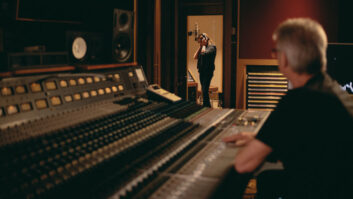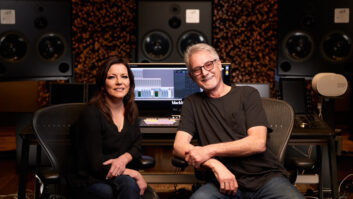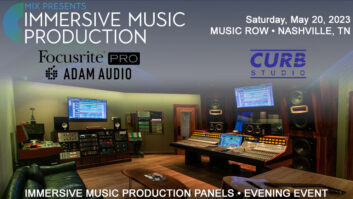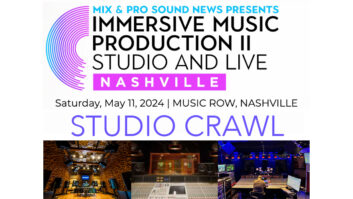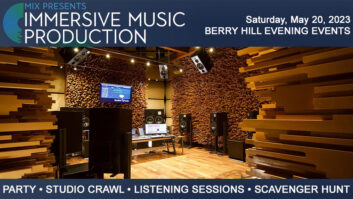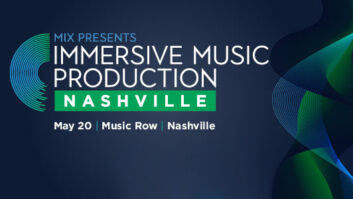Nashville, TN—“When you listen to immersive audio properly, it will change your life. You will never want to go back to stereo,” says John McBride, founder—with his wife, country music artist Martina McBride—of Blackbird Studio in Nashville.
The Blackbird complex currently comprises three buildings housing nine studios, plus Blackbird Academy, a post-secondary audio engineering school. The mic locker is legendary. In fact, the entire facility is legendary, with equipment, both analog and digital, that’s the best of the best.
When McBride talks about listening to immersive audio “properly,” he’s referring to Blackbird’s Studio C, a room that has reset the bar for immersive music production facilities.
When McBride began putting together the first Blackbird building at the turn of the millennium, he had multiple Grammy and TEC Award-winner, producer, engineer and inventor George Massenburg design a room unlike any other. Inspired by the work of German physicist Manfred Schroeder, Massenburg had long harbored a dream to design a fully diffuse production space; he had experimented in the late ’70s with quadratic residue diffusers at The Complex, a studio he co-owned in West L.A. Massenburg sat down with Blackbird studio designer Mike Cronin to map out the dimensions of an open-plan room and, working with Peter D’Antonio, Ph.D., founder of RPG Diffusor Systems, developed a formula to create a primitive root sequence diffuser for Studio C.
Related stories:
• The METAlliance Report: Critical Listening and Critical Evaluation, by George Massenburg, Jan. 30, 2019
• RPG Celebrates 30 Years, June 24, 2013
There are 138,646 individual pieces of wood on the walls of Studio C, and no two pieces are the same length. “I had to come up with a program that would cut 1,732 sheets of 1-inch, 4- by 8-foot MDF [medium-density fiberboard] and number each one—and invent a wall hanging system,” says Massenburg, noting that the wood weighs over 40 tons.
Fast-forward to earlier this year, when Sony demonstrated its 13.2 immersive system at Blackbird. “It got me really excited about the whole immersive thing,” says McBride. Then in June, he ran into Dolby Atmos Music specialist Ceri Thomas (Twitter: @cerithom), who encouraged him to outfit a room at Blackbird for immersive audio work. “And we thought, how perfect would it be to debut it during Summer NAMM?” he says. “Which was in two and a half weeks!”

Almost every room at Blackbird is outfitted with monitors from UK manufacturer ATC. “In 2002, when we were in our first building, I called five or six studio engineers that I knew and respected. I chose ATC because no one complained about them. After buying my first pair of 300s, I fell in love with these speakers. I use them to track, to mix, for reference listening. I trust ATC. That’s why I felt that was the speaker I had to go with” in Studio C, says McBride.
The room already housed a pair of ATC SCM300ASL Pro monitors, “so adding a matching center was a natural choice,” says Ben Lilly, technical sales manager with ATC. As for the speaker models on the walls and the ceiling, Lilly adds, “Dolby’s DART tool helped select suitable monitors based on the room and acoustic data input into the tool.”
The minimum speaker configuration for a Dolby Atmos Music system is 7.1.4. Because of the cubic volume of Studio C, Dolby recommended increasing the number of surround and height speakers to create a 9.1.6 setup: three ATC SCM300ASL Pro monitors across the front, six stand-mounted ATC SCM100ASL Pro monitors on the sides, six flyable ATC SCM100ASL Pro monitors on the ceiling, and six ATC SCM0.1/15ASL Pro subwoofers positioned four across the front and two at the rear. That’s a lot of loudspeakers, but ATC and its U.S. distributor, TransAudio Group, were able to deliver in time. “These guys really came through,” says McBride.
Want more stories like this? Subscribe to our newsletter and get it delivered right to your inbox.
Not surprisingly, it took a team effort to install and commission the new system in time for its July 17 debut, with representatives from ATC, TransAudio Group and Dolby Labs all pitching in. McBride additionally called on Sound Construction owner and structural engineer Dave Mattingly, studio designer Mike Cronin’s former crew chief, to fly the ceiling speakers.
While Studio C was once dominated by an 80-channel SSL 9000K console, it now boasts a minimal setup reflecting modern workflows. The system comprises an Avid Pro Tools rig with a pair of MTRX audio interfaces, four HDX cards, an S3 surface and a Pro Tools Dock, all clocked by an Antelope Audio 10MX. Outboard gear includes, appropriately, Massenburg’s GML 8200 stereo parametric EQ and GML 8900 dynamics processor.
“Listening to the room before the NAMM event was life-changing—I don’t know how else to describe it,” says McBride. “It must be one of the finest environments in which to experience this anywhere. And we’re in a room designed by Massenburg that has this incredible diffusion. It’s like listening in a room without walls.”
The room is already busy. “We were booked five days last week. We’re booked four days this week, four days next week,” McBride reports. Massenburg is included on that schedule, mixing an immersive project for a major artist.
Related: UMG to Remix Thousands of Songs in Dolby Atmos, May 24, 2019
The potential audience for immersive music is growing. Millions—soon to be billions—of consumers can listen to Dolby Atmos on their phones. Sound bars are getting cheaper and better. Universal Music Group is putting its weight behind Dolby Atmos Music, leading the way with remixes of milestone Beatles releases. But as Massenburg observes, what else can be remixed into Dolby Atmos will depend on what assets remain in the archives. “We don’t know how many multitracks Universal lost in the 2008 fire that they’re not admitting to,” he says.
“It’s exciting because it’s experimental, and it’s not about hit radio or loudness. It’s a new palette for mixers to work with,” says Massenburg. He plans to remix an album by Dawn Langstroth, Anne Murray’s daughter, that he produced in 2007 with one eye on the future: “When I recorded that at Blackbird, I had four microphones in the air.”
Related: Blackbird Studio Founds Academy, May 9, 2013
McBride is bullish about the future of immersive music—obviously, having just committed a significant amount of money to Studio C’s upgrades. “We’re developing a curriculum to teach Atmos to our Blackbird Academy students. The fact that we’re going to start teaching this is going to be another great reason to come here.”
He’s especially excited about the logical next step in the march toward immersive music. “I can’t wait for artists to discover this. They’re going to be writing and having songs mixed with definite ideas about what’s in the front, what’s behind you, what’s above you. That’s going to open up a whole new world.”
Blackbird Studio • www.blackbirdstudio.com
TransAudio Group • www.transaudiogroup.com


